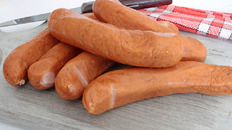Meats and Sausages
Saucisse de Montbéliard
The quality of pig’s meat and particularly the fat is greatly influenced by the diet, especially during the fattening period. The pigs used for producing Saucisse de Montbéliard consume a lot of whey which is the liquid remaining after milk has been curdled and strained. Since the agriculture in the Franche-Comté region is oriented mainly towards cattle farming, with a particular focus on dairy production, the region has a well-developed cheese making industry where exist many cheese diaries known locally as ‘fruitières’. These dairies produce whey, a choice raw material for animal feed, in particular for pigs and that has enabled whey-based pig rearing to develop in the Franche-Comté region.
Saucisse de Montbéliard is produced in the Franche-Comté region (Doubs, Jura, Haute-Saône and Territoire de Belfort). This area is heavily wooded (44%) and many resinous trees (fir, pine) grow here, especially in the mountainous region. Locally available wood was always employed in traditional smoking so it comes as no surprise that Saucisse de Montbéliard develops a peculiar smokey flavor as it is smoked with soft resinous wood. This technique is in direct contrast to other types of smoked sausages in France or Europe which are smoked using wood from deciduous trees. This smoking by means of resinous wood is an extremely specific characteristic of ‘Saucisse de Montbéliard’ giving it its amber color and a smoked taste closely linked to the area in which it is produced.
The practice, which was initially developed in Haut-Doubs, is the origin of the expertise in smoking that then spread throughout the entire Franche-Comté region with the appearance of smoking structures based on the principles of the ‘thué’. A ‘thué’ was the farm’s heating center and smokehouse, used to temporarily store pork in order to dry, smoke and thus preserve it.
Saucisse de Montbéliard is smoked: over wood from resinous trees for at least 6 hours in a conventional smokehouse, 9 hours in a combination of a traditional smokehouse and a conventional smokehouse, 12 hours in a traditional smokehouse. Other characteristics are:course mincing with a grain of at least 6 mm, a light amber color due to the smoking, a slightly seasoned taste thanks to cumin or caraway and pepper as well as other spices (usually garlic) included in the mixture, if any.
| Meats | Metric | US |
|---|---|---|
| Lean pork from shoulder, leg or loin | 700 g | 1.54 lb |
| Back fat | 300 g | 0.66 lb |
Ingredients per 1000g (1 kg) of meat
| Salt | 18 g | 3 tsp |
| Pepper | 2.0 g | 1 tsp |
| Cumin or ground caraway | 1.0 g | 1/2 tsp |
| Nutmeg | 1.0 g | 1/2 tsp |
| Water | 30 ml | 1 fl oz |
Instructions
- Grind meat with 1/4 - 5/16” (6-8 mm) plate.
- Grind fat with 1/4 - 5/16” (6-8 mm) plate.
- Mix ground meat with salt and water until sticky. Add spices and fat and mix again.
- Stuff into 36 mm hog casings.
- Apply smoke at around 25-30° (77-86° F) for 6 hours or at 50° C (120° F) for 2-3 hours. Local producers use wood from locally grown trees, often soft resinous type (fir, pine) - which is in contrast to majority of sausages smoked in Germany or Eastern Europe which are smoked using hardwoods.
- Cook in water at 80° C (176° F) for 35 minutes.
- Cool in cold water, dry and refrigerate.


















